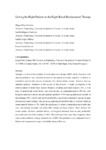Getting the right patient on the right renal replacement therapy

View/
Use this link to cite
http://hdl.handle.net/2183/32909Collections
- Investigación (FCS) [1293]
Metadata
Show full item recordTitle
Getting the right patient on the right renal replacement therapyDate
2012-05Citation
Pérez Fontán M, Rodríguez-Carmona A, López-Muñiz A, García-Falcón T. Getting the right patient on the right renal replacement therapy. Contrib Nephrol. 2012;178:40-46.
Abstract
[Abstract] Adequate selection of the modality of renal replacement therapy (RRT), ideally based on well-planned predialysis care, informed decision by the patient and timely initiation of dialysis, is essential to optimize the outcome of patients with chronic kidney disease. However, there are important practical limitations to the success of this process. A major consequence is the underutilization of home-based dialysis therapies, including peritoneal dialysis (PD). A wide array of medical and social factors have been invoked as contraindications to PD, but well-designed studies have shown that most patients (probably >70%) starting dialysis are suitable for this technique. PD is feasible and may be preferred by a significant proportion of patients in many claimed unfavorable settings. The practicing nephrologist should be able to: disclose which are insurmountable barriers to PD, clarify the significance of relative contraindications in individual cases, and identify favorable and unfavorable settings for home dialysis. These abilities will permit quality education, justified advice, well-targeted informed decision and, predictably, successful selection of the modality of RRT. This article provides some clues to approach these issues in three different settings: planned start of RRT after predialysis care, unplanned start of dialysis and programmed changes of modality during follow-up.
Keywords
Renal Replacement Therapy
Editor version
ISSN
0302-5144





